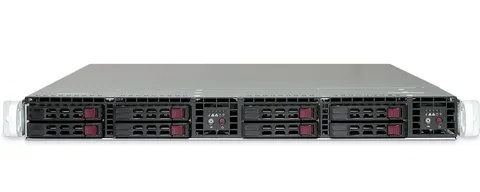In today's data-driven age, the sheer volume of information we produce is staggering. From the hundreds of billions of IoT devices connected to the Internet to the billions of posts and streams on social media, traditional methods of data processing are being challenged. This is where edge computing comes in.
Edge computing focuses on processing data close to the source. It has emerged as a potential game-changer. Now, the question here arises: is Edge the answer to our ever-increasing data demands?
Let’s take a closer look at edge servers, discover their capabilities, and consider their advantages and disadvantages to understand their role in the data processing landscape.
A Short Introduction To Edge Server
An edge server is a small data center physically closer to the data source than a centralized cloud server. Edge servers can be found anywhere in the network, from factory floors to retail stores to autonomous vehicles. This provides an entry point into a network. Think of edge servers as mini data centers that are located at the "edge" of the network.
Let's understand this with a scenario: Imagine a busy city with a large central courthouse. Earlier, all legal cases, large or small, used to go through the central courthouse. It causes delays and congestion. On the other hand, edge computing is similar to small courthouses in neighborhoods. This allows quicker resolution of smaller cases while the central courthouse deals with more complex cases.
Understanding the Importance of Edge Computing
Here, we have discussed several compelling reasons for edge computing's popularity, including:
Optimized Bandwidth Utilization
Edge computing reduces the strain on congested network bandwidth when processing the data at the edge server. This is important in environments with limited or unreliable internet connectivity, such as out-of-the-way locations or areas with weak internet infrastructure. It also helps free up bandwidth for other important tasks, as it takes less data to travel long distances. This improves network performance and is ideal for use cases like video conferences, remote surgery, and real-time data streaming.
Better Security
Some sensitive data, should not be transmitted over open networks, as it can expose sensitive information to security risks. Edge computing, on the other hand, enables local data processing and storage. It can improve data security and compliance. For example, in a hospital, medical devices can process patient data on edge servers. It reduces the risk of data exposure while being transmitted to a remote cloud.
Decreased Latency
Processing data on edge servers eliminates the need to send massive amounts of data to a centralized cloud. This helps reduce latency, as transferring data from one source to another takes less time.
This is really important for applications requiring real-time decisions, like autonomous vehicles and industrial automation. Why? Even a few milliseconds of latency can result in huge problems.
Edge computing has become more important for applications such as:
- Autonomous vehicles
- Industrial automation
- High-frequency trading
- Autonomous vehicles need to make instantaneous decisions by analyzing real-time sensor data.
- The automation industry can optimize production processes and prevent equipment failures by analyzing real-time data.
- In a constantly changing market, high-frequency trading requires high-speed data processing to make informed investment decisions.
Rapid Perception
Edge computing bridges the gap between on-premise data processing and on-site data analysis. It also enables faster analysis and the generation of insights by analyzing data closer to the source. You can improve your business's operational efficiency and gain a competitive advantage by making data-driven decisions promptly.
For example, a manufacturing plant can quickly identify and respond to potential equipment malfunctions using data analyzed on the edge server. It helps avoid costly downtime.
To OptimizeCost
Scalability is a key element of cloud computing, but processing and storing huge amounts of data comes with a cost. You can shift some of the workloads to local servers with edge computing. It reduces your dependency on costly cloud resources for day-to-day operations, resulting in a more cost-effective data processing solution. Make sure you know how to balance the processing capacity of edge servers with their cost.
The Emergence of the Machines
The IoT (Internet of Things) is here to stay. With billions of devices connected to the internet, there’s no end to the data flow. This is possible only with edge computing. Edge servers can collect, process, and analyze data from those devices locally. It does not rely on the cloud to do the heavy lifting. This means better device management, quicker response times, and increased efficiency in IoT applications such as smart homes, connected cities, and industrial automation.
Unique Challenges of Edge Computing
Edge computing offers many surprising benefits, but some challenges need to be addressed.
- Restricted Processing Efficiency: Edge servers tend to be smaller and less powerful than traditional data centers. It may be unable to handle large amounts of data or complex calculations.
- Protective Measures: Data sharing across multiple edge servers creates new security holes. Implementing strong security policies is crucial to safeguarding sensitive information at the edge.
- Enhanced Intricacy Level: Edge server management adds another layer of complexity to your IT infrastructure. It involves deploying hardware and software. You should also follow maintenance, ensuring everything is secure.
- Difficulties with Establishing Consistent Norms: The edge computing ecosystem is still in its early stages of development. The lack of standardization in hardware, software, and protocols can lead to problems with interoperability and barriers to adoption.
Bottom Line:
As the demand for data continues to grow in the digital age, so does the need for a new process. Edge computing offers a compelling solution due to its low latency, high bandwidth efficiency, data security, and fast insight generation.
While challenges such as increased complexity, low processing power, and a lack of standardization are still present, technological advances and the development of collaborative edge-cloud approaches can pave the way for edge computing to become an essential part of our data-driven future.


No comments yet